Nakayama Castle (Mino)
-Castle ahead of long ridge like slide-
Overview
Name: Nakayama castle (Nakayama-jo)
Alias:
Place: Aioi Hachiman-cho Gujo city, Gifu
Location: 35.72140845143566, 136.9419975771443
Type: Mountain Castle
Built: 14th century?
Remaining remnants: Stone walls, clay walls and moats
Title:
Nakayama castle (中山城) is located on the top of Nakayama mountain, one of about 200 meter height from hillside at about 5 kilometer south from the center of current Gujo city. Being sandwiched by two rivers, the mountain has a narrow and straight line slope directly goes down from hilltop to hillside, like a large slide.
Aioi area where Nakayama castle stands at the south edge of central Gujo Hachiman and an entrance to city area from southward. In addition to this, Aioi area is a merging point of main road of Gujo Kaido road runs along with Nagara-gawa river, and a mountainous road from Gifu area or Yamagata area today becomes Route 256. Because of these conditions Aioi area is an important point to control traffic of the area.
Precise year is unknown but Nakayama castle was originally built by local lord Fute clan. Fute clan served to Sumi clan, a traditional major local lord lived in the north from current Gujo city. At this point Nakayama castle might be southern border of Sumi clan for both of offence and defense.
In the latter half of 15th century, Sumi clan activated at battles under Toki clan, the governor of Mino province (Gifu prefecture). Sumi clan achieved new territory around Yamagata area, which was close to Oga castle which was a mountain base of Toki clan. But Sumi clan was involved in the conflict between Toki clan and deputy governor Saito clan thus lost their territory at Yamagata area.
Furthermore, continuous battles at distant area weakened the power of Sumi clan. In 1541, Sumi clan was ruined by To clan, which was the lord of Shinowaki castle (Gifu prefecture), and Nakayama castle might be seized by To clan at this time. To clan also used Nakayama castle as south guard of territory, preparing conflict for Toki clan or Saito clan.
However, To clan also lost their power during conflict with Saito clan or Asakura clan, a strong warlord only 30 kilometer westward from Gujo area. Furthermore there arose internal conflict, and finally To clan was ruined by their relative Endo clan at Todonoyama castle in 1550.
Endo clan which became the lord of whole Gujo area artfully survived among strong warlords such as Nobunaga Oda (153-1582), the warlord of Owari province (western half of Aichi prefecture) seized Mino province, Shingen Takeda (1521-1583), the warlord of Kai province (Yamanashi prefecture) who controlled Hida province (northwestern part of Gifu prefecture) at the next of Gujo area, or Asakura clan.
After the death of Nobunaga Oda in the incident of Honnoji in 1582, Endo clan was involved into internal conflicts between sons and retainers of Nobunaga. Endo clan was hostile to Hideyoshi Hashiba (1537-1598) who won this struggle then was moved from Gujo area. Instead of Endo clan, Inaba clan which was an important retainer of Nobunaga was appointed as the lord of Gujo area.
Inaba clan which held Gujo area and north half of Seki area used Gujo Hachiman castle as their main base, and improved branch castle such as Nakayama castle or Ohora castle into modern ones with stone walls. Especially Nakayama castle was the most important branch castle directly protects the entrance into Gujo area, thus relative of Inaba clan was placed at this castle.
Ruins of Nakayama castle spread over 1 kilometer long straight line ridge like a slide. At the end of the hill there are several flat areas used as farming field was originally a riding place. Above of this area there are two layer square shaped areas now used as a ground of abandoned local hall which were originally the ground of the residence of the lord.
Just above this terrace there is a small peak whose one slope is artificially processed, This might be a ruin of lower fort, but most part of structure was destructed. Ahead of this area, there is a long and sheer climbing road which has several dry moats and clay walls.
Ahead of sheer slope, there is a main part of Nakayama castle. Central area of the castle is a square shaped one of about 20 meter long, which had entrances with stone walls at its southwestern corner and southeastern corner. Southeastern corner might be a main entrance into this area, and there is a ruin of folded path with stone walls.
Below of central area, there are several terraces also protected by stone walls. At the north of central area, there is a deep dry moat which has a stone built well at the bottom. Total size of hilltop area is about 200 meter long, and its size is just next to Gujo Hachiman castle.
In 1600, at the battle of Sekigahara, Inaba clan at first belonged to Mitsunari Ishida (1560-1600), the former chief magistrate of Hideyoshi Toyotomi (1537-1598), and Endo clan who belonged to Ieyasu Tokugawa (1543-1616), the largest lord under Hideyoshi, attacked Gujo Hachiman castle to recover their former territory.
Endo clan recovered vacant Gujo Hachiman castle, but Inaba clan turned to Ieyasu then returned to Gujo area and assaulted Gujo Hachiman castle. Inaba clan recovered Gujo Hachiman castle, and after post-war process Inaba clan moved to Usuki castle (Oita prefecture) with larger territory then Endo clan finally returned as the lord of Gujo area.
Endo clan did not need branch castle any more abolished them including Nakayama castle. Now no building was left but half broke stone walls well remain on hilltop area. It is necessary to walk long climbing road without indication, and there are confusing ruins on the way. But once reached to hilltop area without getting lost, small but composed ruin of stone wall is enjoyable.
20 minutes walk from Nagaragawa Tetsudo Etsumi-Nansen line Aioi station to entrance of climbing road. 20 minutes drive from Tokai-Hokuriku Jidoshado Expressway Gujo-Hachiman interchange or Minami interchange. 40 minutes walk from entrance of climbing road to hilltop castle but it is necessary to follow slight trace of road covered with bushes without indication and partially collapsed.
Type: Mountain Castle
Built: 14th century?
Remaining remnants: Stone walls, clay walls and moats
Title:
Brief History
Nakayama castle (中山城) is located on the top of Nakayama mountain, one of about 200 meter height from hillside at about 5 kilometer south from the center of current Gujo city. Being sandwiched by two rivers, the mountain has a narrow and straight line slope directly goes down from hilltop to hillside, like a large slide.
Aioi area where Nakayama castle stands at the south edge of central Gujo Hachiman and an entrance to city area from southward. In addition to this, Aioi area is a merging point of main road of Gujo Kaido road runs along with Nagara-gawa river, and a mountainous road from Gifu area or Yamagata area today becomes Route 256. Because of these conditions Aioi area is an important point to control traffic of the area.
Origin of Nakayama castle
Precise year is unknown but Nakayama castle was originally built by local lord Fute clan. Fute clan served to Sumi clan, a traditional major local lord lived in the north from current Gujo city. At this point Nakayama castle might be southern border of Sumi clan for both of offence and defense.
In the latter half of 15th century, Sumi clan activated at battles under Toki clan, the governor of Mino province (Gifu prefecture). Sumi clan achieved new territory around Yamagata area, which was close to Oga castle which was a mountain base of Toki clan. But Sumi clan was involved in the conflict between Toki clan and deputy governor Saito clan thus lost their territory at Yamagata area.
Furthermore, continuous battles at distant area weakened the power of Sumi clan. In 1541, Sumi clan was ruined by To clan, which was the lord of Shinowaki castle (Gifu prefecture), and Nakayama castle might be seized by To clan at this time. To clan also used Nakayama castle as south guard of territory, preparing conflict for Toki clan or Saito clan.
Transition of lords of Gujo area
However, To clan also lost their power during conflict with Saito clan or Asakura clan, a strong warlord only 30 kilometer westward from Gujo area. Furthermore there arose internal conflict, and finally To clan was ruined by their relative Endo clan at Todonoyama castle in 1550.
Endo clan which became the lord of whole Gujo area artfully survived among strong warlords such as Nobunaga Oda (153-1582), the warlord of Owari province (western half of Aichi prefecture) seized Mino province, Shingen Takeda (1521-1583), the warlord of Kai province (Yamanashi prefecture) who controlled Hida province (northwestern part of Gifu prefecture) at the next of Gujo area, or Asakura clan.
After the death of Nobunaga Oda in the incident of Honnoji in 1582, Endo clan was involved into internal conflicts between sons and retainers of Nobunaga. Endo clan was hostile to Hideyoshi Hashiba (1537-1598) who won this struggle then was moved from Gujo area. Instead of Endo clan, Inaba clan which was an important retainer of Nobunaga was appointed as the lord of Gujo area.
Inaba clan which held Gujo area and north half of Seki area used Gujo Hachiman castle as their main base, and improved branch castle such as Nakayama castle or Ohora castle into modern ones with stone walls. Especially Nakayama castle was the most important branch castle directly protects the entrance into Gujo area, thus relative of Inaba clan was placed at this castle.
Structure of Nakayama castle
Ruins of Nakayama castle spread over 1 kilometer long straight line ridge like a slide. At the end of the hill there are several flat areas used as farming field was originally a riding place. Above of this area there are two layer square shaped areas now used as a ground of abandoned local hall which were originally the ground of the residence of the lord.
Just above this terrace there is a small peak whose one slope is artificially processed, This might be a ruin of lower fort, but most part of structure was destructed. Ahead of this area, there is a long and sheer climbing road which has several dry moats and clay walls.
Ahead of sheer slope, there is a main part of Nakayama castle. Central area of the castle is a square shaped one of about 20 meter long, which had entrances with stone walls at its southwestern corner and southeastern corner. Southeastern corner might be a main entrance into this area, and there is a ruin of folded path with stone walls.
Below of central area, there are several terraces also protected by stone walls. At the north of central area, there is a deep dry moat which has a stone built well at the bottom. Total size of hilltop area is about 200 meter long, and its size is just next to Gujo Hachiman castle.
Afterward of castle
In 1600, at the battle of Sekigahara, Inaba clan at first belonged to Mitsunari Ishida (1560-1600), the former chief magistrate of Hideyoshi Toyotomi (1537-1598), and Endo clan who belonged to Ieyasu Tokugawa (1543-1616), the largest lord under Hideyoshi, attacked Gujo Hachiman castle to recover their former territory.
Endo clan recovered vacant Gujo Hachiman castle, but Inaba clan turned to Ieyasu then returned to Gujo area and assaulted Gujo Hachiman castle. Inaba clan recovered Gujo Hachiman castle, and after post-war process Inaba clan moved to Usuki castle (Oita prefecture) with larger territory then Endo clan finally returned as the lord of Gujo area.
Endo clan did not need branch castle any more abolished them including Nakayama castle. Now no building was left but half broke stone walls well remain on hilltop area. It is necessary to walk long climbing road without indication, and there are confusing ruins on the way. But once reached to hilltop area without getting lost, small but composed ruin of stone wall is enjoyable.
Access
20 minutes walk from Nagaragawa Tetsudo Etsumi-Nansen line Aioi station to entrance of climbing road. 20 minutes drive from Tokai-Hokuriku Jidoshado Expressway Gujo-Hachiman interchange or Minami interchange. 40 minutes walk from entrance of climbing road to hilltop castle but it is necessary to follow slight trace of road covered with bushes without indication and partially collapsed.


































































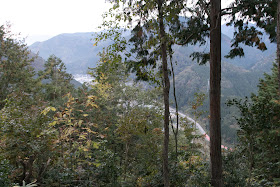







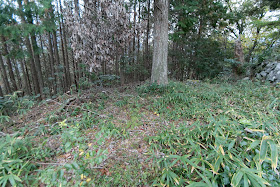






























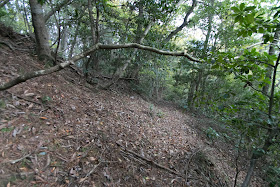




























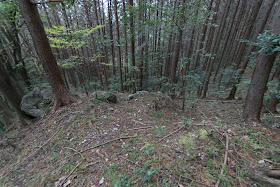
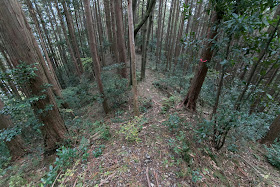






No comments:
Post a Comment